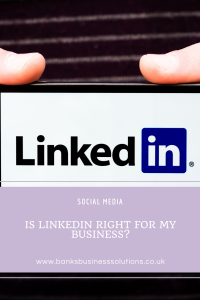Is LinkedIn Right For My Business?
LinkedIn is one of those confusing social media channels where it’s difficult to tell what it really is, and how to use it.
Is it a social media channel at all or simply where people upload their CVs?
Can you really network on LinkedIn or is it about finding people and moving to offline connections?
Is there really a point to sharing content on there?
Those are questions I often hear asked and have wondered myself, but I do use LinkedIn to promote myself and my business and here’s what I’ve learned along the way.
LinkedIn is about relationship building
Whichever way you think about LinkedIn – as a social media website or a place to find and hire professionals, etc. It’s all about building relationships with others.
If you’re hiring a new employee or outsourcing to a professional, you check their LinkedIn profile to understand their skills, experiences and have a read of their testimonials, right?
If you see something in the timeline that you agree with, you go to their profile and see if it’s worth sending a connection request and creating a rapport. You want to check their experiences and skills to gauge their credibility and authority in making that statement or sharing that content.
And I think when you understand LinkedIn in that way, it’s easier to figure out how to use it for your business marketing. Instead of promoting yourself, or your business products or services you have just one goal in mind – building relationships and creating rapport with others, and it’s so much easier to plan content around that.
Decide who you need to be building relationships with
Some businesses are very individual-focused compared to others. Typically, those who offer services are more reliant on creating rapport and making contacts than those who sell products, but both business types have people they need to make relationships with.
For those selling products, you’re likely to be connecting with industry leaders, marketing support, website support, suppliers, financial support, corporate buyers, etc. These are the people who will support you and your business to enable you to sell more products.
If you’re selling services, it’s the other side of the coin. You’re looking for people to build relationships with that either need your services or can refer you to people who need those services. Even if you’re a B2C business, if it’s services you offer the relationships you make on LinkedIn are about finding new consumers to offer your services to.
Whether you’re actively looking to hire/be hired or not, it’s still worth spending some time on LinkedIn making new connections and building up those relationships so when you do have that need again, you’ve already got the foundations in place to make it quicker and easier to do so.
Share content that makes you look credible
What makes you want to build a relationship with someone else?
In a business sense, you’re probably looking for credibility, authority, expertise, reputation, etc. You want to know that they know what they’re talking about, they’re good at what they do, others see them as reputable and you can trust them.
And that’s what you need others to believe about you.
That’s how LinkedIn can help you build your business. It’s putting the credibility there for people to make the decision to buy from you or work from you. Whether people check out your profile or come across you in their feed, they need to gain the sense that you’re easy to trust and relate to quickly and easily.
So, the kinds of content you put out on LinkedIn needs to make that happen. It’s the testimonials and reviews, the blogs sharing your expertise, quick posts that help people in some way by sharing your skills and knowledge, etc.
It might be helpful to make two lists – proof, and help.
The proof list is content ideas that prove you’re credible and reputable. What kind of content exists about you and what do you need to create to help others see you as a good person to build a relationship with?
The second list is about how you can help the people you want to build your relationships with. What are their problems and how can you help them? Even if what you do doesn’t help them directly, do you have some experiences with their problems that can give them some insight or advice?
Being helpful and being credible is the key to any good form of marketing, but I do believe it’s particularly the case for LinkedIn. I hope that this blog has helped you to understand LinkedIn a little better and how you can use it for your business.

